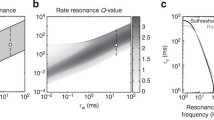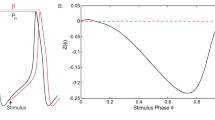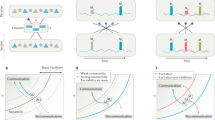Abstract
The synchronous oscillatory activity characterizing many neurons in a network is often considered to be a mechanism for representing, binding, conveying, and organizing information. A number of models have been proposed to explain high-frequency oscillations, but the mechanisms that underlie slow oscillations are still unclear. Here, we show by means of analytical solutions and simulations that facilitating excitatory (E f) synapses onto interneurons in a neural network play a fundamental role, not only in shaping the frequency of slow oscillations, but also in determining the form of the up and down states observed in electrophysiological measurements. Short time constants and strong E f synapse-connectivity were found to induce rapid alternations between up and down states, whereas long time constants and weak E f synapse connectivity prolonged the time between up states and increased the up state duration. These results suggest a novel role for facilitating excitatory synapses onto interneurons in controlling the form and frequency of slow oscillations in neuronal circuits.





Similar content being viewed by others
References
Abbott, L. F., & Blum, K. I. (1996). Functional significance of long-term potentiation for sequence learning and prediction. Cerebral Cortex, 6, 406–416.
Anderson, J., Lampl, I., Reichova, I., Carandini, M., & Ferster, D. (2000). Stimulus dependence of two-state fluctuations of membrane potential in cat visual cortex. Nature Neuroscience, 3, 617–621.
Bazhenov, M., Timofeev, I., Steriade, M., & Sejnowski, T. J. (2002). Model of thalamocortical slow-wave sleep oscillations and transitions to activated States. Journal of Neuroscience, 22, 8691–8704.
Buzsaki, G., & Draguhn, A. (2004). Neuronal oscillations in cortical networks. Science, 304, 1926–1929.
Compte, A., Sanchez-Vives, M. V., McCormick, D. A., & Wang, X. J. (2003). Cellular and network mechanisms of slow oscillatory activity (<1 Hz) and wave propagations in a cortical network model. Journal of Neurophysiology, 89, 2707–2725.
Contreras, D., & Steriade, M. (1995). Cellular basis of EEG slow rhythms: a study of dynamic corticothalamic relationships. Journal of Neuroscience, 15, 604–622.
Contreras, D., Timofeev, I., & Steriade, M. (1996). Mechanisms of long-lasting hyperpolarizations underlying slow sleep oscillations in cat corticothalamic networks. Journal of Physiology, 494(Pt 1), 251–264.
Engel, A. K., Fries, P., & Singer, W. (2001). Dynamic predictions: oscillations and synchrony in top-down processing. Nature Reviews Neuroscience, 2, 704–716.
Galarreta, M., & Hestrin, S. (1998). Frequency-dependent synaptic depression and the balance of excitation and inhibition in the neocortex. Nature Neuroscience, Plos, 1, 587–594.
Holcman, D., & Tsodyks, M. (2006). The emergence of up and down states in cortical networks. Plos. 2, e23.
Kozloski, J., Hamzei-Sichani, F., & Yuste, R. (2001). Stereotyped position of local synaptic targets in neocortex. Science, 293, 868–872.
Lampl, I., Reichova, I., & Ferster, D. (1999). Synchronous membrane potential fluctuations in neurons of the cat visual cortex. Neuron, 22, 361–374.
Markram, H., & Tsodyks, M. (1996). Redistribution of synaptic efficacy between neocortical pyramidal neurons. Nature, 382, 807–810.
Markram, H., Wang, Y., & Tsodyks, M. (1998). Differential signaling via the same axon of neocortical pyramidal neurons. Proceedings of the National Academy of Sciences of the United States of America, 95, 5323–5328.
Moruzzi, G., & Magoun, H. W. (1995). Brain stem reticular formation and activation of the EEG. 1949. Journal of Neuropsychiatry and Clinical Neurosciences, 7, 251–267.
Parga, N., & Abbott, L. F. (2007). Network model of spontaneous activity exhibiting synchronous transitions between up and down states. Frontiers in Neuroscience, 1, 57–66.
Reyes, A., Lujan, R., Rozov, A., Burnashev, N., Somogyi, P., & Sakmann, B. (1998). Target-cell-specific facilitation and depression in neocortical circuits. Nature Neuroscience, 1, 279–285.
Sanchez-Vives, M. V., & McCormick, D. A. (2000). Cellular and network mechanisms of rhythmic recurrent activity in neocortex. Nature Neuroscience, 3, 1027–1034.
Sanchez-Vives, M. V., Nowak, L. G., & McCormick, D. A. (2000). Cellular mechanisms of long-lasting adaptation in visual cortical neurons in vitro. Journal of Neuroscience, 20, 4286–4299.
Shu, Y., Hasenstaub, A., & McCormick, D. A. (2003). Turning on and off recurrent balanced cortical activity. Nature, 423, 288–293.
Silberberg, G., & Markram, H. (2007). Disynaptic inhibition between neocortical pyramidal cells mediated by Martinotti cells. Neuron, 53, 735–746.
Silberberg, G., Wu, C., & Markram, H. (2004). Synaptic dynamics control the timing of neuronal excitation in the activated neocortical microcircuit. Journal of Physiology, 556, 19–27.
Steriade, M., Amzica, F., & Contreras, D. (1996). Synchronization of fast (30–40 Hz) spontaneous cortical rhythms during brain activation. Journal of Neuroscience, 16, 392–417.
Steriade, M., McCormick, D. A., & Sejnowski, T. J. (1993a). Thalamocortical oscillations in the sleeping and aroused brain. Science, 262, 679–685.
Steriade, M., Nunez, A., & Amzica, F. (1993b). A novel slow (<1 Hz) oscillation of neocortical neurons in vivo: Depolarizing and hyperpolarizing components. Journal of Neuroscience, 13, 3252–3265.
Steriade, M., Timofeev, I., & Grenier, F. (2001). Natural waking and sleep states: A view from inside neocortical neurons. Journal of Neurophysiology, 85, 1969–1985.
Stern, E. A., Kincaid, A. E., & Wilson, C. J. (1997). Spontaneous subthreshold membrane potential fluctuations and action potential variability of rat corticostriatal and striatal neurons in vivo. Journal of Neurophysiology, 77, 1697–1715.
Thomson, A. M., & Deuchars, J. (1997). Synaptic interactions in neocortical local circuits: Dual intracellular recordings in vitro. Cerebral Cortex, 7, 510–522.
Thomson, A. M., Deuchars, J., & West, D. C. (1993). Single axon excitatory postsynaptic potentials in neocortical interneurons exhibit pronounced paired pulse facilitation. Neuroscience, 54, 347–360.
Timofeev, I., Grenier, F., Bazhenov, M., Sejnowski, T. J., & Steriade, M. (2000). Origin of slow cortical oscillations in deafferented cortical slabs. Cerebral Cortex, 10, 1185–1199.
Tsodyks, M., Pawelzik, K., & Markram, H. (1998). Neural networks with dynamic synapses. Neural Computation, 10, 821–835.
Turrigiano, G. (2007). Homeostatic signaling: The positive side of negative feedback. Current Opinion in Neurobiology, 17, 318–324.
Wang, X. J. (1999). Synaptic basis of cortical persistent activity: The importance of NMDA receptors to working memory. Journal of Neuroscience, 19, 9587–9603.
Wang, Y., Gupta, A., & Markram, H. (1999). Anatomical and functional differentiation of glutamatergic synaptic innervation in the neocortex. Journal of Physiology (Paris), 93, 305–317.
Wang, Y., Markram, H., Goodman, P. H., Berger, T. K., Ma, J., & Goldman-Rakic, P. S. (2006). Heterogeneity in the pyramidal network of the medial prefrontal cortex. Nature Neuroscience, 9, 534–542.
Wilson, H. R., & Cowan, J. D. (1972). Excitatory and inhibitory interactions in localized populations of model neurons. Biophysical Journal, 12, 1–24.
Acknowledgment
We thank the anonymous reviewers for their helpful comments. M.T. is partially supported by Israeli Science Foundation, Irving B. Harris Foundation and Abe & Kathryn Selsky Foundation. G.S. is supported by an HFSP long-term fellowship. O.B. is partially supported by the Azrieli foundation and the Kahn center for system biology.
Author information
Authors and Affiliations
Corresponding author
Additional information
Action Editor: Nicolas Brunel
Appendices
Appendix A—Stability of dynamics with a “frozen” J ie
When short time scales are considered, the stability of Eq. (1) can be determined as a function of the parameter J ie . We use Eq. (1) in a matrix form for the supra-threshold linear regime.
The condition for stability is a negative trace and positive determinant. Since Trace(A) is independent of J ie , we chose the simulation parameters (see Table 1) which render it negative, thus allowing stability for some J ie values. The stability is thus determined by Det(A), defining \(J_{ie}^{th} \) as a border between the stable and the unstable regimes:
\(J_{ie}^{th} \) represents the criterion for stability as follows: when J ie >\(J_{ie}^{th} \), E and I relax to a constant, and when J ie >\(J_{ie}^{th} \), the solution diverges.
Appendix B—estimating the oscillation borders
The right border of the oscillation regime (J R in Fig. 2(a)) can be calculated by searching for the \(J_{ie}^0 \) value for which the steady state becomes stable. This can be done by calculating the eigenvalues of the linearized dynamics at the steady state:
where x ss , u ss , E ss are the steady state values.
The left border of the oscillation regime (JL in Fig. 2(a)) is defined by a divergence of the oscillations, and was thus searched for by simulating the network until the border between a stable limit cycle and divergent behavior was found.
Rights and permissions
About this article
Cite this article
Melamed, O., Barak, O., Silberberg, G. et al. Slow oscillations in neural networks with facilitating synapses. J Comput Neurosci 25, 308–316 (2008). https://doi.org/10.1007/s10827-008-0080-z
Received:
Revised:
Accepted:
Published:
Issue Date:
DOI: https://doi.org/10.1007/s10827-008-0080-z




